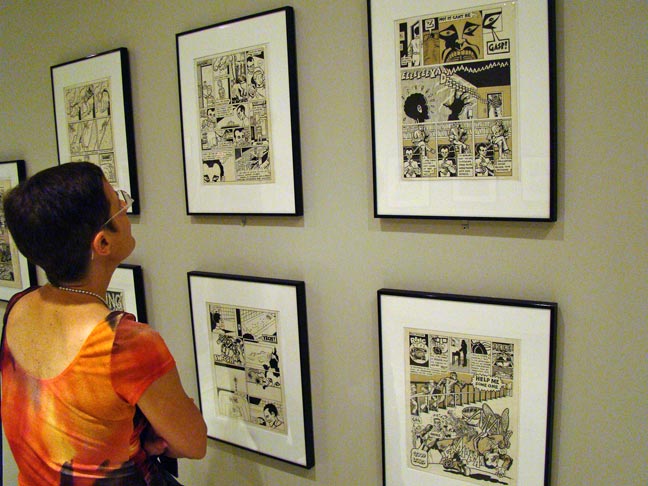The announcement of a museum exhibit on graphic novels at the James A. Michener Museum of Bucks County is challenging in several ways.
While museum exhibits of comic art in the US and Canada date back to the 1970s (earlier exhibitions happened in Europe, but the only one I can find a a record of is the 1968 exhibition of comic-strip art at Musée des arts decoratifs, Palais du Louvre) with the Steranko: Graphic Narrative show in Winnipeg, the 1980s and the Whitney Comic Art show, involvement of Art Speigleman in the Beyond High & Low show in response to the High & Low Show at MOMA, their presence, while desirable, poses other challenges.
Comics are relatively accepted as an art form now, due in no small part to the Graphic Novel demarcation. Note that the exhibit at the Michener is a "graphic novel" exhibit, not a "comic art" exhibit, despite using panels from a Spirit comic, not a graphic novel per se, in its informational web page. Also, please take note of the sloppy research in attributing the nomenclaute of "commonly accepted as the first graphic novel" to A Contract With God. While the significance of this book cannot and should not be denied, even Eisner acknowledged Masreel's woodcut books as predecessors. Others worked in "wordless books", and the term "picture novel" was used on the cover of the 1950 paperback It Rhymes With Lust and its successor from the same publisher, Case of the Winking Buddha.
The original It Rhymes With Lust has been reprinted twice, first in The Comics Journal and second as a facsimile edition with a new foreword from Dark Horse Comics, the third largest comic company in the US.
Are we to infer sloppy research on the part of the Michener Gallery in its statement that A Contract With God is " is commonly accepted as the first to be called a graphic novel", or is that simply a limitation of copy space, since Milt Gross's name is also cited as being part of the exhibit? Gross's He Done Her Wrong, a 1930 book billed as "The Great American Novel in Pictures", back in print from Fantagraphics, is another work that predates Eisner.
This is journeyman stuff. Any undergrad researcher could discover most of this in a matter of a few minutes.
However, it's rather easy to get one's back up about such things. It may very well be a case of sloppy copy writing and nothing more, especially given the inclusion of Gross in the exhibit. And as comics scholars, many of us have a slight persecution complex. No, really, we do!
All that given, there's the larger question of acceptance and its related costs and advantages.
True, comics are now in museums, although often trough the aforementioned back door of the "graphic novel". The notable exceptions are museums devoted to comics, like San Francisco's stunning Cartoon Art Museum, whose current show, Graphic Details: Confessional Comics by Jewish Women includes the work of old friend Trina Robbins. We've linked to Trina's site numerous times, so one more won't hurt!
What do we gain and what do we lose by comics gaining social acceptance?
For one thing, comics may wither. This is a possible byproduct of the acceptance of manga and graphic novels. After all, why pay $3 -4 per issue for "floppies", old school flimsy paper comics of 24 -32 pages including ads, when you could wait for the collection (not properly a "graphic novel", unless that was the creators' initial intent) and get the whole thing in a more durable form for a lower cumulative price, in many cases?
That's a bit a doom and gloom thing. I firmly believe that the floppy, or conventional comic book, will endure in some capacity, much as live theater still exists but is no longer the entertainment/cultural mainstay it was once was. However, when great books like daytripper sell a meager 9,800 copies, it's hard to avoid a small sense of foreboding.
The other thing we lose with social acceptance of comics is the imprimatur of the outlaw cachet.
So many things regarded as social taboos- pinball, motorcycles, tattoos, comics- have been accepted, with that acceptance ranging from a near-mandate (tattoos) to becoming passe' (pinball). The cadre of misfits has been assimilated to varying degrees.
That has its up side. Comics are a more than valid art form, and deserve to be taken seriously, contingent on content, of course. I have little patience for the latest bombastic, senses-shattering, "this will change everything" multi-book epic from Marvel or DC. Civil War was socially relevant and genuinely important as a metaphor for a divided nation at odds over the false distinction between freedom and security. Crisis on Infinite Earths was a necessary bit housecleaning, with some strong storytelling. They're worthwhile and fun. But enough grandeur already. Just tell me a decent story and I'm there.
My point is that comics deserve to be taken seriously, AS COMICS. Museums are great and comics deserve a place in them. But please don't damn them with faint praise by insisting on the "graphic novel" badge to "legitimize" the work. A great show of Comic Book Art needs no excuses for itself.
It's a bloody comic book. That's all it needs to be. If it's a good one, let it stand on its own merits.


